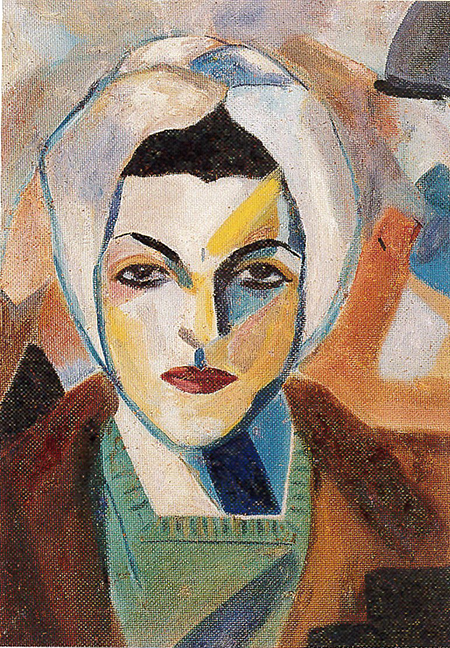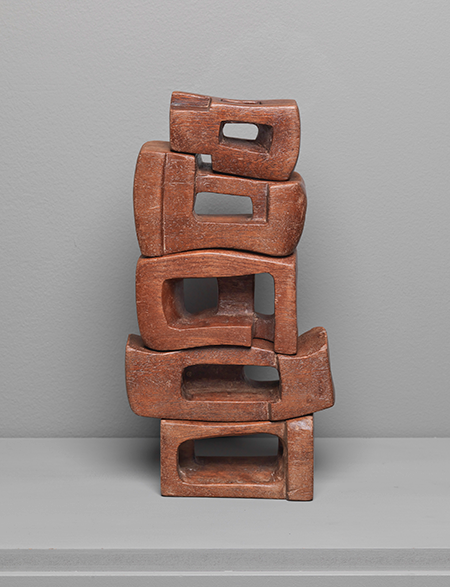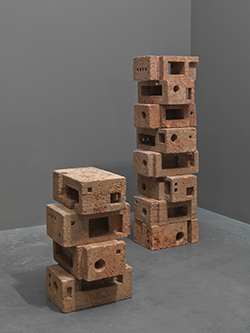The painting is scarred. This is what I thought when I encountered a small work entitled “Two=One” (1947-51), by the Lebanese artist Saloua Raouda Choucair. It sits in the third gallery of this show, tucked away as if we were meant to walk past it. The rectangular painting, composed on wood, presents the artist’s decades-long interest in geometrical forms, in surfaces mathematically cut into halves and quarters, but also incorporating the irregularities of curving lines and shapes, the colors balancing in their echoing tones. Like much of Choucair’s work, this is an abstraction that is highly composed.
- Saloua Raouda Choucair
Tate Modern, London.
Through October 20, 2013.
What strikes me about this painting is more its history than its paint. The wood has a large gash in the middle, a nearly square hole as if something has punctured the wood from behind. This hole’s edge is rough with splinters contrasting against the flat smooth colors of orange and pink and purple. In many places the surface is cracked and scraped. If you look more closely you notice on the top center a small shard of glass cut into the surface, its perpendicular precision looks as if it is coming out of the work rather than shot into it.
It would be easy to imagine the artist intended such effects, the balance of color and shape distorted on purpose by such violent damage. At first it reminded me of Joan Miró’s “Burnt Canvases” series of the 1970s, those impressive and nearly empty rectangular paintings half torched, the canvas edges crisp and black. But Miró had a motive in burning his paintings. “Two=One” was an accident, a casualty of a bomb explosion near the artist’s studio in Beirut in 1984 during the country’s 16-year civil war. When the debris was cleaned away, Choucair took the painting as she had found it and wrapped it in cloth and kept it in her studio. Journalist Kealen Wilson-Goldie recounts when Tate Modern curators stumbled upon this painting on a sunny summer morning of 2012, they wondered if it was appropriate to even include it in this first major exhibition of Choucair’s work outside of her native Lebanon. They feared it would turn Choucair’s creative output into a political story of war and destruction. They wondered if such a painting, and the history it conjures, would distract from the artist’s concerns for abstractionism, and her efforts at merging traditions of Middle Eastern aesthetics with an international modernism. In the end, they dismissed their concerns. As Wilson-Goldie reported, Choucair’s daughter, the artist Hala Schoukair, found little worry in the painting place in the show: “Everyone who stayed here the whole time during the war was damaged.”
Choucair, who at 97 still lives in her native Beirut not far from where she grew up, is little known beyond the borders of her country. Though she hasn’t been working in the studio for years now, interest in her work has gained more attention lately. This small but intriguing show properly situates her art in the history of international modernism.
Choucair was born in Beirut in 1916 amidst a blockade of the city by Ottoman forces fighting against the British in one of the echoes of conflict produced by World War I beyond the borders of France and Germany. Her father was drafted into the Ottoman army, sent off to Damascus where he died of typhoid fever. When the war ended and the defeated Ottoman and German empires fragmented, Beirut and the surrounding region became a pawn in a huge European chess game, dividing the area and peoples, and creating a mandate governed by France that included modern day Lebanon and Syria. In 1943, when France was occupied by Germany in another world war, Lebanon achieved its independence. The history Choucair grew up in was marked by competing conflicts of Arabs and Christians of differing sects and beliefs migrating and displaced on purpose and by force by one empire or another.
We might be able to see Choucair’s abstract art beyond the social and political changes in Lebanon. But it was hard for me to forget the historical realities that surround her works, even in those not damaged by a bomb attack. In her paintings from the 1940s and 1950s and more acutely her sculptures, which focused her energy and creativity from the 1960s onward, there is a constant exploration into reconciling the geometrical with the organic, the duality with the singular. Inherent in much of her art is a shaping of harmony out of the discord of fragments. What makes “Two=One” intriguing is not so much how it over determines Choucair’s work amidst the civil war, but rather how it reminds us that even abstract art can’t escape the everyday realities of culture and conflict. In considering the many quiet and compelling works in this show, I wondered what other realities I might find in Choucair’s abstractions?

Self Portrait, 1943
One of the first works you encounter is a self-portrait, done in 1943, the same year Lebanon achieved its independence. It is a small but intensely imagined painting. At 27, Choucair presents an image of herself that is strikingly serious and balanced, a portrait almost puzzle-like in its composition of shapes and contrasting warm and cool hues. In Beirut she studied art with Omar Onsi and later Moustafa Farroukh, both painters known for their realists works that reflected more the 19th century tradition of academic painting than 20th century experiments in form and color. But it was in modernism that she would find a visual language, one that was of the moment and the possible future rather than the past.
From 1943 we jump to the late 1940s and early 1950s. We move from Beirut to Paris, where Choucair studied art and eventually joined the atelier of noted modernist artist Fernand Léger. Léger had just arrived back to Paris after his exile in the United States during the war. When Choucair entered his studio, he was one of the most important artists of the post-war, Parisian avant-garde.
His influence, shaped by the aesthetics of Matisse and Cezanne among others, is evident in Choucair’s paintings in this period. Their flat surfaces present human forms and material objects in heavy, primitive shapes and primary hues. But the content reflects Choucair’s own vision, most acutely in the female subjects that populate the works. Choucair’s women are nearly formless. In the series “Les Peintres Célèbres,” for example, we encounter four women seated or lounging, one reading a book, another holding a painter’s palette. One reclines along the floor naked, but not naked, as it is the shape and look of her face that we are drawn to, her body a mere oblong of color. Choucair plays with the tradition of the odalisque in these works, turning the image of this exotic, naked woman into its own abstraction, where all desire disappears and we are left simply wondering about this community of women sitting together almost unconcerned with our gaze.
Also from this period is the painting “Paris-Beirut” (1948) that juxtaposes a sea blue Cleopatra’s Needle, that obelisk in the center of Place de la Concord in Paris, encircled with purple colored walls and arched facades of her native city. This blending of Paris and Beirut merges a number of geographies, not only with the two cities, but also the obelisk itself, a relic of Luxor, Egypt set in Paris in the early 19th century. There is energy in this work that mixes European and Middle Eastern symbols into a harmony of color and form, reflecting both personal and cultural experiences for Choucair.
This balancing is most acutely imagined in her sculptures created in the late 1950s onward, after her return to Beirut. The second gallery space presents a number of these sculptures in wood and stone. Many of the works were done in a series, their repetitions an exploration of the works possibilities. Many are deceptively simple, such as her “Poem in Nine Verses” (1966-8) which layers nine pieces of wood, each uniquely carved and angled, stacked neatly one on top of the other, there individual shapes finding interlocking unity, forming a small wall. But these pieces can all be rearranged, placed in more discordant ways, less solid and flat, or separated out, each singular form left on its own. So often in these sculptures, the certainty of their shape is never very fixed.
While “Poem in Nine Verses” evokes the structures of poetry — each piece a single verse in the structure and rhythm of the poem — they, like many of her sculptures, conjure a sense of the architectural. The wall panel tells us that given another life, she would have been an architect. In the early 1950s she was intrigued with Le Corbusier’s “Cité Radieuse” a nearly self-contained housing complex in Marseille, realized on the rubble of a bombed out and war-torn Marseille. Originally entitled “Unité d’Habitation,” a phrase that is haunted by the traumas of World War II, the building balanced an intricacy of design with a modernist sparseness that fascinated the young Choucair. She traveled to Marseille to see the building for herself, taking photographs from the road. The building was still under construction, its scaffolding surrounding it off in the distance of a flat landscape. Her snapshots captured the building in process of becoming, small black and white images that she kept for decades. These snapshots fill a small glass display in this show, reminding us how the building, and the idea behind it, was vital to her sculptures and the many models of public art that she created over the years that were never realized.
There is a deep sense of modern architecture’s influence in many of her sculptures of modular shapes and repetitive surfaces. This element creates works that are rarely solid forms but, rather, that open up in places allowing us to look inside or through. Even the ones carved of stone offer some way through, holes or small windows into the work. What may look like a solid wall or column is in fact more porous to let in light. This quality is most acutely seen in her “Sculpture with One Thousand Pieces” (1966-8), which could in fact be a plan for a residential housing building, its square structure layered like a high-rise, each floor opening in places to allow us to look inside, all the pieces coming together to form an intricate whole of dark wood. I learned later she used this sculpture as a lamp, a light dropped into the center, illuminating dots of light like stars in a clear night sky. Again, geometry and form turns into the patterns of the organic. Like the apartment complex, Choucair’s sculptures feel as if they are still under construction, filled with possibilities if we can imagine them.
Smaller, more organic sculptures such as the “Duel” series from the late 1970s presents shapes carved out of two pieces of curved wood, one darker than the other, which, as they wrap around each other, fit perfectly together or can easily be pulled apart and stand on their own. Like the more rectangular “Poem” series, these can be rearranged in ways that reshape the sculpture, singularity and unity always a choice.

“Poem,” 1963-5
The “Duel” series was part of the “Road to Peace: Painting in Times of War” exhibition at the Beirut Art Center in 2009. As curator Kristine Khouri noted, while the 16-year civil war in Lebanon shut down many art galleries, art shows continued, and people still attended them, sometimes at great risk. But amidst the shows many works representing the violence of war, images, and sculptures that are hard to ponder, Choucair’s dueling sculptures with their simplistic and smooth surfaces look strikingly innocent, like everyday objects we would put on the bookshelf. They are odd works to consider as testaments to war, for they draw us away from witnessing war towards the potential of harmony. And this is a reality that Choucair’s works constantly give us: not the one in front of us, but the possibility of a world we can’t really see.
In 1957, as Choucair was developing her sculptural explorations in Beirut, Albert Camus delivered a lecture in Sweden entitled “Create Dangerously.” What Camus meant by this phrase was that an artist has the duty to offer a world not as it is but as we might like it to be, creating a reality that “has no reality yet.” For Camus, the discussions about realism in art are merely a distraction. The task of the artist, he writes, is not to present a world as we understand it and experience it, but rather to create an “image of reality we recognize without ever having known it.”
The best of Choucair’s sculptures reach towards this idea of creative expression. They present objects that can be reimagined, looked through, reconfigured, balancing harmony among the fragments, unity and separateness always a choice. Such elements reflect not only Choucair’s interests in the abstractions of mathematical forms, but also illuminate an imagined future, a creative unity, amidst a reality of diverse interests and conflicts, of political power and religious forces. In this sense, her sculptures do something powerful: They offer us an idea of reality as a constantly imagined reshaping of what might be possible. • 24 June 2013




